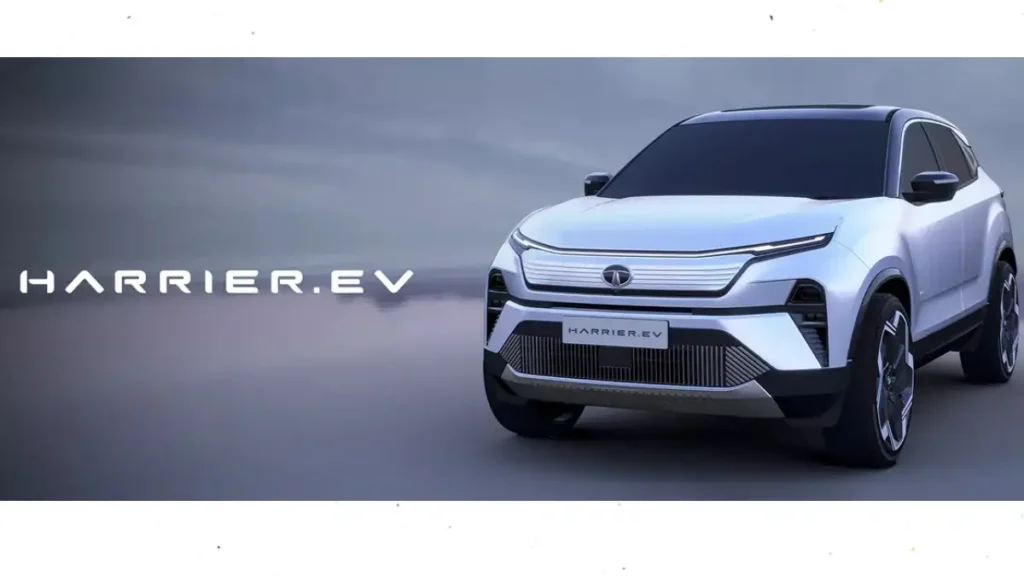Tata Harrier EV Launch Confirmed! Latest Leaks Uncover Battery Specs and Range
Tata Motors continues to lead the charge in India’s electric vehicle (EV) space. This time, the spotlight is on the Tata Harrier EV, a much-anticipated addition to the brand’s growing electric lineup. Recent leaks have revealed exciting details, including the possible launch date, battery size, and estimated range.

Clearly, Tata Motors is preparing to make a bold statement with this electric SUV.
Expected Launch Timeline for the Harrier EV
According to fresh industry reports, Tata plans to launch the Harrier EV in early 2025. Some insiders even suggest that the rollout could happen as early as January or February. This timeline aligns perfectly with the company’s broader strategy of electrifying its SUV portfolio within the next two years.
Moreover, several test vehicles have already been spotted across India, indicating that Tata has moved into the final stages of pre-production testing. With development moving at this pace, the official unveiling seems just around the corner.
Battery Size and Driving Range: What to Expect
Tata has not confirmed the technical specifications yet. However, multiple sources indicate that the Harrier EV might come with a battery pack ranging from 60 kWh to 70 kWh. This upgrade would mark a significant leap over the Nexon EV’s 40.5 kWh battery.
Thanks to this larger capacity, the Harrier EV could deliver an impressive range of 500 to 550 kilometers under standard test conditions. If accurate, these figures would position the SUV ahead of most competitors in its class, such as the MG ZS EV, BYD Atto 3, and Hyundai Kona Electric.
Consequently, long-distance travel in an Indian electric SUV could finally become more practical and accessible.
A Platform Built for the Future
Tata has already shown its ability to successfully convert fuel-based vehicles into electric models. For instance, the Punch EV, launched earlier this year, was built on Tata’s GEN 2 architecture, which supports both internal combustion and electric powertrains.
Now, the Harrier EV will likely use a more advanced setup, possibly based on the Acti.EV platform. This new foundation is designed to house bigger batteries, provide better thermal management, and support advanced features like regenerative braking and fast charging.
Thanks to this evolution in design, the Harrier EV should offer a smoother ride and greater efficiency than earlier models.
Design Upgrades: Sleek, Smart, and Electric-Ready
The Harrier EV won’t just be a battery-powered version of the standard model. Based on spy shots and concept images, Tata plans to give the SUV a distinct appearance. Notably, it could feature:
- A closed-off front grille for improved aerodynamics
- Unique LED lighting elements and EV-themed blue highlights
- Reworked bumpers and flush-fitting alloy wheels
- A restyled rear fascia with updated branding
Inside, the cabin will likely undergo significant improvements. Expect a larger touchscreen, wireless charging, new upholstery, connected car technology, and perhaps Tata’s next-generation AI-based infotainment system.
Clearly, the Harrier EV aims to feel futuristic, not just functional.
Could Tata Offer an AWD Variant?
Interestingly, several reports hint at a dual-motor all-wheel-drive (AWD) version of the Harrier EV. If true, this would be a first for Tata’s EV lineup.
By placing motors on both axles, Tata can provide enhanced grip, better acceleration, and improved off-road capabilities. For customers who love adventure or simply want more power, this could be a major selling point.
Thus, the Harrier EV might attract a wider range of buyers than the current EV options available in India.
Fast Charging and Smart Technology
Charging anxiety remains a key concern for EV buyers. Thankfully, Tata appears to have addressed this with the Harrier EV. The SUV is expected to support 150 kW DC fast charging, which can top up the battery from 0 to 80% in under an hour. For everyday use, customers will likely receive a 7.2 kW AC wall box charger.
In addition, the Harrier EV could include:
- Vehicle-to-Load (V2L) capability for powering appliances
- Vehicle-to-Grid (V2G) integration for future-ready charging
- Remote diagnostics and OTA software updates
- Advanced safety systems like adaptive cruise control and lane-keeping assist
All these features would place the Harrier EV on par with global competitors in terms of smart mobility.
Impact on the Indian EV Landscape
Tata Motors already dominates India’s electric passenger vehicle market, and the Harrier EV could strengthen that position further. Most electric SUVs available today are either compact or priced at a premium. However, the Harrier EV aims to strike the perfect balance between price, performance, and space.
Experts estimate that the base variant could be priced around ₹27 to ₹30 lakh (ex-showroom). This pricing would offer an affordable yet premium alternative to higher-end EVs from global brands.
As a result, the Harrier EV could become a breakthrough product in India’s mid-size SUV segment.
Conclusion: Is the Harrier EV a Game-Changer?
All signs point toward the Tata Harrier EV being a bold step forward—not just for Tata Motors but also for India’s evolving electric vehicle market. With a spacious design, promising battery specs, and smart features, the SUV seems built for both everyday users and long-distance travelers.
Tata has already proven its EV expertise with the Nexon EV and Punch EV. Now, with the Harrier EV, the company appears ready to compete in a higher segment—offering more range, more power, and more technology.
As the official launch nears, one thing is clear: the Harrier EV has the potential to redefine what Indian buyers expect from an electric SUV.






